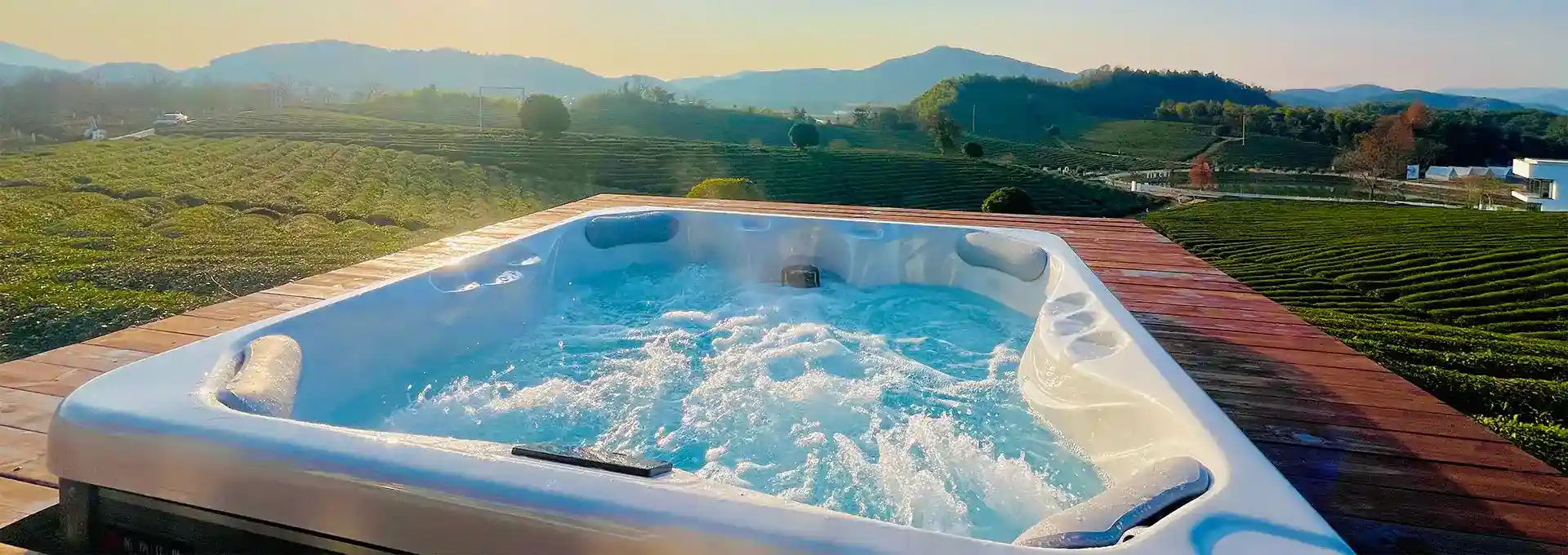How to Ground a Hot Tub?
2024-09-26 09:43:08
Properly grounding a hot tub is crucial for ensuring the safety and optimal functioning of your relaxing oasis. Whether you're installing a new hot tub or maintaining an existing one, understanding the grounding process is essential. This guide will walk you through the steps and considerations for grounding a hot tub effectively, helping you create a secure environment for your aquatic retreat.
What are the electrical requirements for an inground swim spa?
Inground swim spas, like hot tubs, require proper electrical setup to function safely and efficiently. The electrical requirements for an inground swim spa can vary depending on the model and features, but there are some general guidelines to consider.
Typically, inground swim spas require a dedicated 220-240 volt, 50-60 amp circuit. This high-voltage circuit is necessary to power the various components of the swim spa, including pumps, heaters, and jets. Some larger or more feature-rich models may require up to 100 amps or even multiple circuits.
The electrical panel for your swim spa should be equipped with a ground fault circuit interrupter (GFCI) breaker. This safety device quickly shuts off power if it detects any imbalance in the electrical current, which could indicate a potential shock hazard. The GFCI breaker is a critical component in protecting users from electrical accidents.
When planning the electrical setup for your inground swim spa, it's essential to consult with a licensed electrician who is familiar with local codes and regulations. They can ensure that your electrical system meets all safety standards and is capable of handling the power demands of your specific swim spa model.
The wiring for an inground swim spa must be properly sized to handle the amperage required. Typically, 6 gauge copper wire is used for 50 amp circuits, while 4 gauge copper wire is necessary for 60 amp circuits. The wiring must be run through conduit to protect it from damage and ensure longevity.
It's important to note that the electrical connection for an inground swim spa should be installed by a professional electrician. This is not a DIY project, as improper installation can lead to serious safety hazards and potential damage to your swim spa.
In addition to the main power supply, you may need to consider other electrical requirements for your inground swim spa. This could include lighting, audio systems, or even Wi-Fi connectivity for smart spa controls. These additional features may require separate low-voltage connections or be integrated into the main power system.
When selecting an inground swim spa, pay close attention to the manufacturer's specifications regarding electrical requirements. This information will help you plan your installation and ensure that your home's electrical system can accommodate the swim spa without the need for extensive upgrades.
Remember that proper grounding is essential for the safe operation of your inground swim spa. The grounding process helps protect against electric shock and ensures that any stray electrical currents are safely directed into the ground rather than through the water or spa users.
How deep should an inground swim spa be?
The depth of an inground swim spa is a crucial factor that affects both its functionality and safety. When considering the ideal depth for your inground swim spa, several factors come into play, including the intended use, user preferences, and safety considerations.
Typically, inground swim spas range in depth from 3.5 to 6 feet (1.07 to 1.83 meters). The most common depth for inground swim spas is around 4 to 5 feet (1.22 to 1.52 meters). This range provides a good balance between swimming depth and safety for most users.
For swimming and exercise purposes, a depth of at least 4 feet (1.22 meters) is generally recommended. This depth allows most adults to comfortably perform swimming strokes and aquatic exercises without touching the bottom. It also provides enough resistance for effective water-based workouts.
If the primary purpose of your inground swim spa is for relaxation and hydrotherapy, a shallower depth of 3.5 to 4 feet (1.07 to 1.22 meters) may be more suitable. This depth allows users to sit comfortably on built-in seats or benches while still having their upper body above water for easy breathing and conversation.
For families with children or individuals who prefer a shallower swim area, some inground swim spas feature a gradual slope or multiple depth zones. This design allows for a shallower end (around 3.5 feet or 1.07 meters) that transitions to a deeper swimming area. This versatility accommodates users of different heights and swimming abilities.
It's important to note that the depth of your inground swim spa may also be influenced by local building codes and safety regulations. Some areas have specific requirements for pool and spa depths, especially if the installation is considered a residential pool. Always check with your local authorities to ensure compliance with all relevant regulations.
When deciding on the depth of your inground swim spa, consider the height of the primary users. The ideal depth should allow most adults to stand comfortably with their head and shoulders above water. This ensures safety and ease of use for a wide range of users.
For serious swimmers or those looking to use the swim spa for intensive training, a depth of 5 to 6 feet (1.52 to 1.83 meters) may be preferable. This greater depth provides more room for swimming strokes and reduces the risk of touching the bottom during vigorous exercise.
Remember that the deeper your inground swim spa, the more water it will hold. This impacts not only the initial filling costs but also ongoing maintenance and heating expenses. A deeper spa will require more energy to heat and maintain temperature, so factor this into your long-term budget considerations.
Safety should always be a top priority when determining the depth of your inground swim spa. Ensure that there are clear depth markings visible to all users, and consider installing grab bars or handrails for added security. If your swim spa has varying depths, make sure the transitions are clearly marked and gradual to prevent accidents.
What is the difference between a swim spa and a hot tub?
While swim spas and hot tubs both offer aquatic relaxation and therapy, they have distinct differences in design, functionality, and intended use. Understanding these differences can help you choose the right option for your needs and preferences.
Size and Shape:
One of the most noticeable differences between swim spas and hot tubs is their size and shape. Swim spas are generally much larger, typically ranging from 12 to 21 feet (3.7 to 6.4 meters) in length. They are usually rectangular, resembling a small pool. This elongated shape provides enough space for swimming and aquatic exercises.
Hot tubs, on the other hand, are smaller and often square or circular in shape. They typically measure between 5 to 9 feet (1.5 to 2.7 meters) in diameter or width. The compact size of hot tubs makes them ideal for smaller spaces and focuses on seating and relaxation rather than swimming.
Functionality:
The primary function of a swim spa is to provide a space for swimming and aquatic exercises. They feature powerful jets at one end that create a current against which users can swim in place. This allows for a continuous swimming experience without the need for a full-length pool. Swim spas often include adjustable current settings to accommodate different swimming abilities and workout intensities.
Hot tubs, conversely, are designed primarily for relaxation, hydrotherapy, and social gatherings. They typically have multiple seats or loungers equipped with jets that provide massage-like water pressure. The focus is on comfort and therapeutic benefits rather than exercise.
Water Temperature:
Swim spas usually operate at lower temperatures compared to hot tubs. The water in a swim spa is typically kept between 78°F and 85°F (25.5°C to 29.4°C), which is comfortable for swimming and exercising. This temperature range helps prevent overheating during physical activity.
Hot tubs, as the name suggests, maintain higher water temperatures, usually between 100°F and 104°F (37.8°C to 40°C). This higher temperature is ideal for relaxation, muscle recovery, and hydrotherapy but would be too warm for extended periods of exercise.
Depth:
Swim spas tend to be deeper than hot tubs to accommodate swimming strokes. As discussed in the previous section, swim spas typically range from 4 to 6 feet (1.22 to 1.83 meters) in depth. This depth allows for comfortable swimming without touching the bottom.
Hot tubs are usually shallower, with depths ranging from 2.5 to 4 feet (0.76 to 1.22 meters). This shallower depth is suitable for seated relaxation and allows users to keep their upper body above water while enjoying the jets.
Features and Accessories:
Swim spas often come equipped with features that enhance the swimming and exercise experience. These may include swim tethers, rowing bars, and exercise equipment like underwater treadmills or bicycle pedals. Many swim spas also include a separate hot tub section, combining the benefits of both types of installations.
Hot tubs focus on comfort and relaxation features. They typically have molded seats with strategically placed jets, mood lighting, waterfall features, and sometimes built-in audio systems. Some high-end models may include features like aromatherapy systems or color therapy lighting.
Energy Efficiency:
Due to their larger size and lower operating temperature, swim spas can be more energy-efficient than hot tubs when it comes to maintaining water temperature. However, the energy required to power the strong swim current can offset this advantage.
Hot tubs, while smaller, need to maintain higher water temperatures constantly. They often come with energy-efficient features like superior insulation and cover systems to help minimize heat loss and reduce energy consumption.
Installation and Placement:
Swim spas, because of their size and weight, often require more extensive installation processes. They may need a reinforced concrete pad and might be partially or fully inground. Their size also means they typically become a permanent fixture in your outdoor space.
Hot tubs are generally easier to install and can be placed above ground on a sturdy, level surface. Many models are portable, allowing for relocation if needed. This flexibility makes hot tubs a popular choice for homeowners who may want to change their outdoor layout in the future.
In conclusion, while both swim spas and hot tubs offer aquatic enjoyment, they serve different primary purposes. Swim spas are ideal for those looking for a space-efficient alternative to a full-size pool, offering the ability to swim and exercise. Hot tubs are perfect for relaxation, hydrotherapy, and social gatherings in a more compact setting. Your choice between the two will depend on your space, budget, and whether you prioritize exercise or relaxation in your aquatic experience.
For more information on hot tub installations and to find out more about our products, please feel free to contact us at info@iparnassus.com.
References
1. Swim University. "How to Ground a Hot Tub Properly."
2. Outdoor Living Today. "Electrical Requirements for Hot Tubs and Swim Spas."
3. Hot Spring Spas. "Hot Tub Electrical Installation."
4. Aqua Magazine. "The Basics of Swim Spa Installation."
5. Bullfrog Spas. "Hot Tub Depth: How Deep Should a Hot Tub Be?"
6. SwimEx. "What's the Best Depth for a Swim Spa?"
7. Master Spas. "Swim Spa Depth: How Deep is a Swim Spa?"
8. Endless Pools. "Swim Spa vs. Hot Tub: Which is Right for You?"
9. PDC Spas. "Swim Spa vs. Hot Tub."
10. Hydropool. "The Difference Between a Swim Spa and a Hot Tub."



